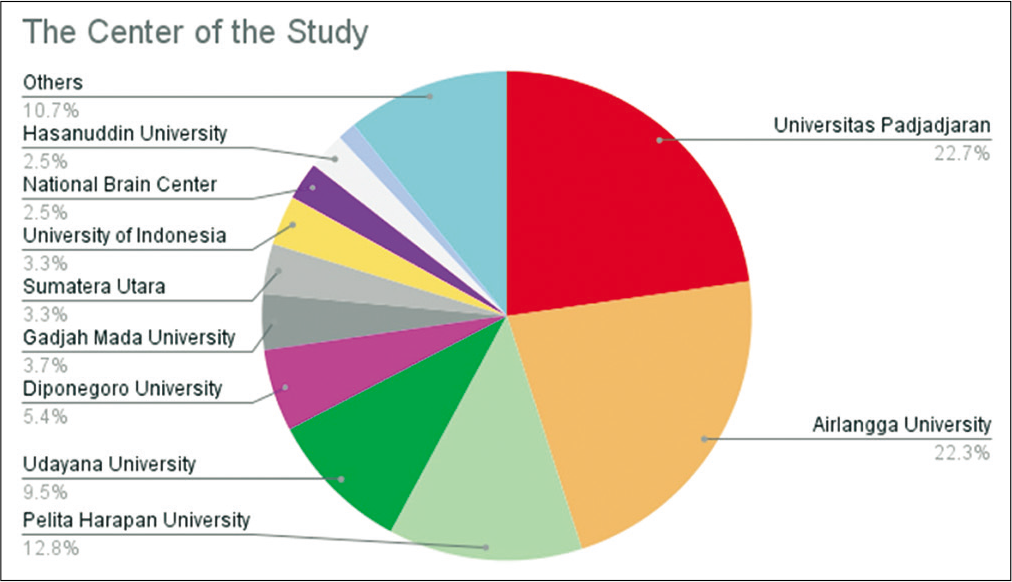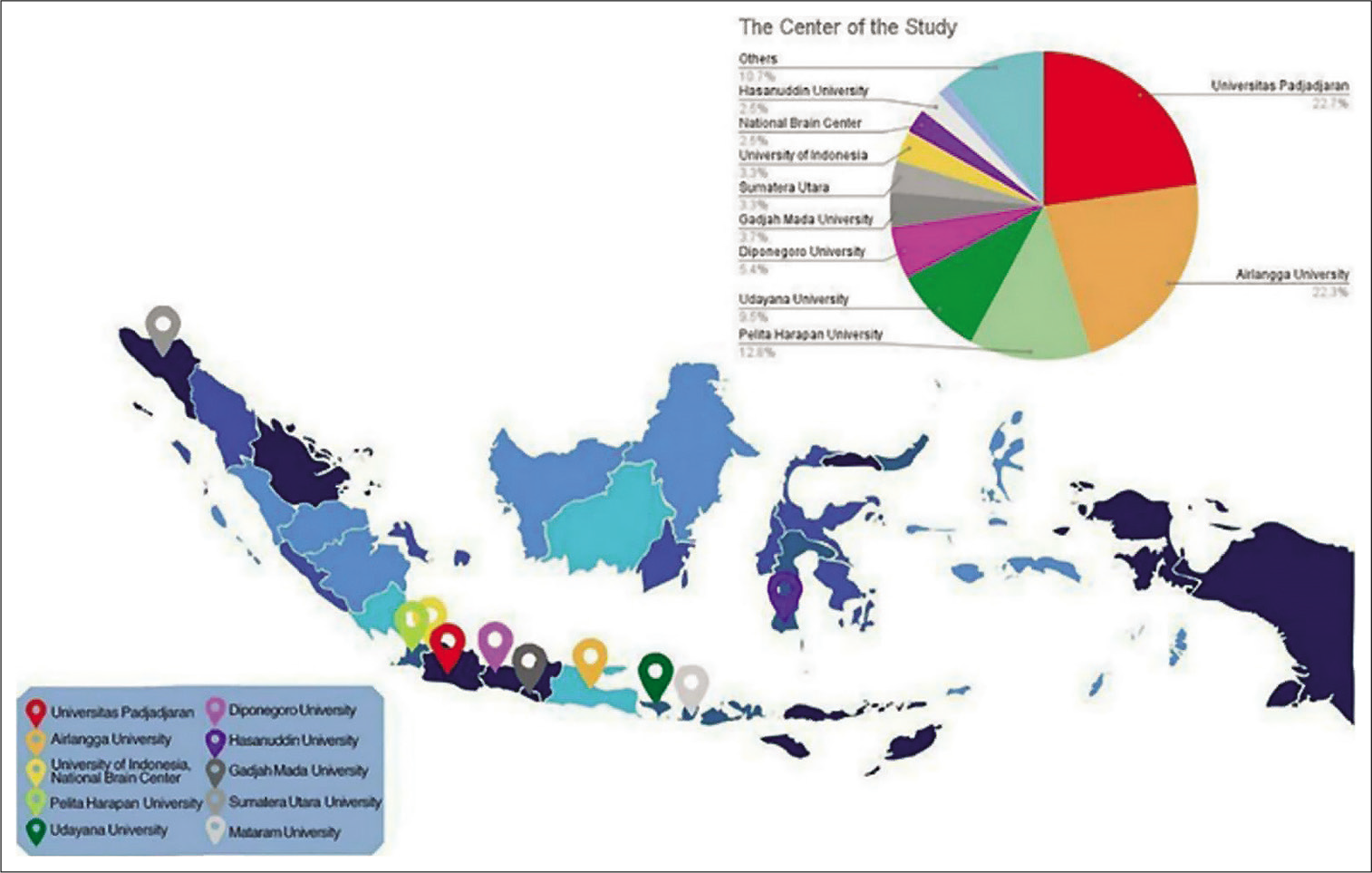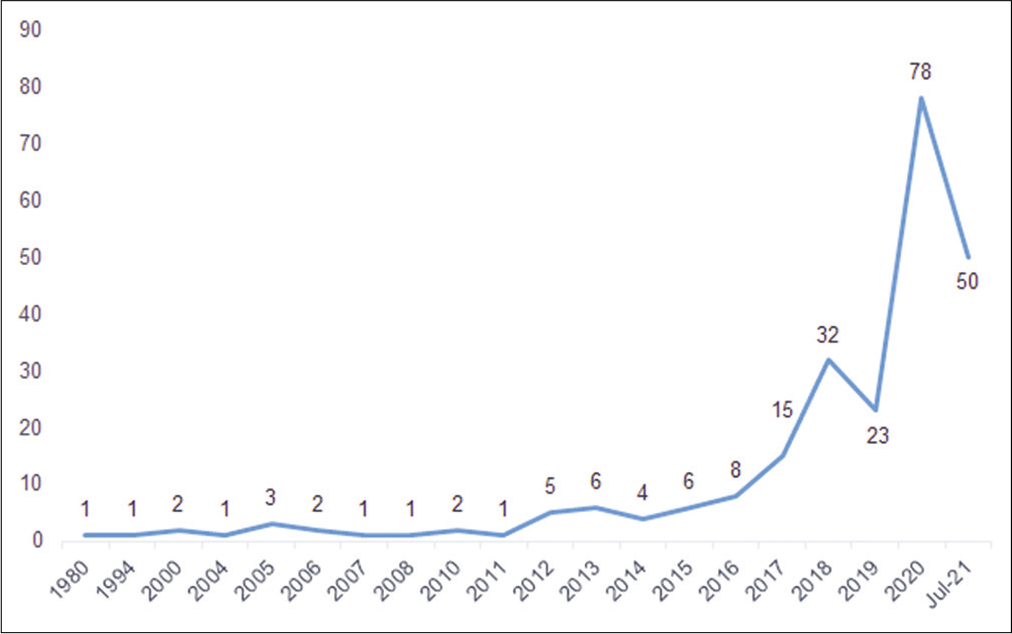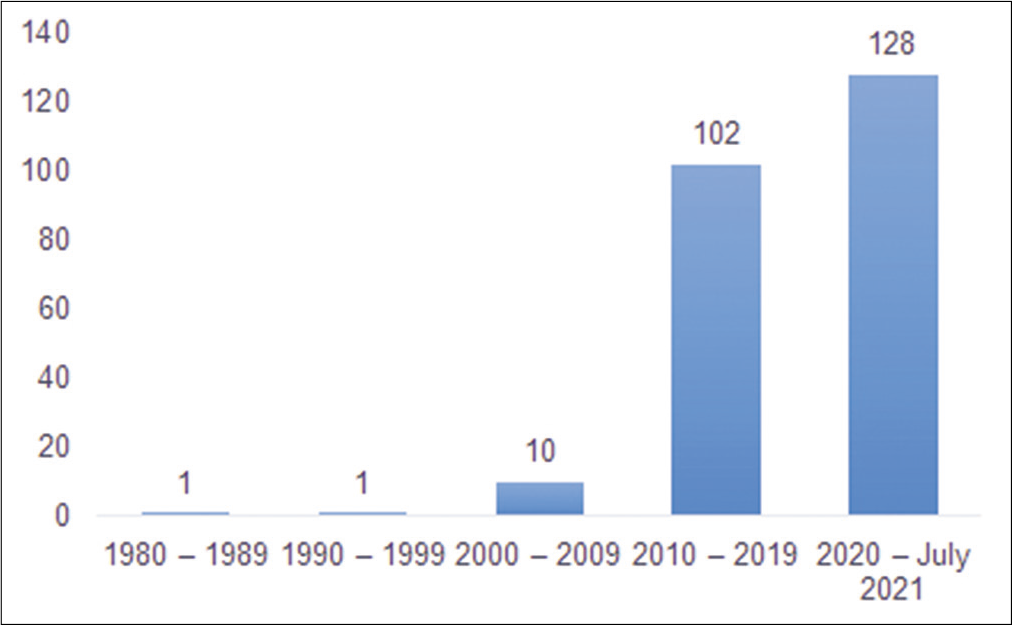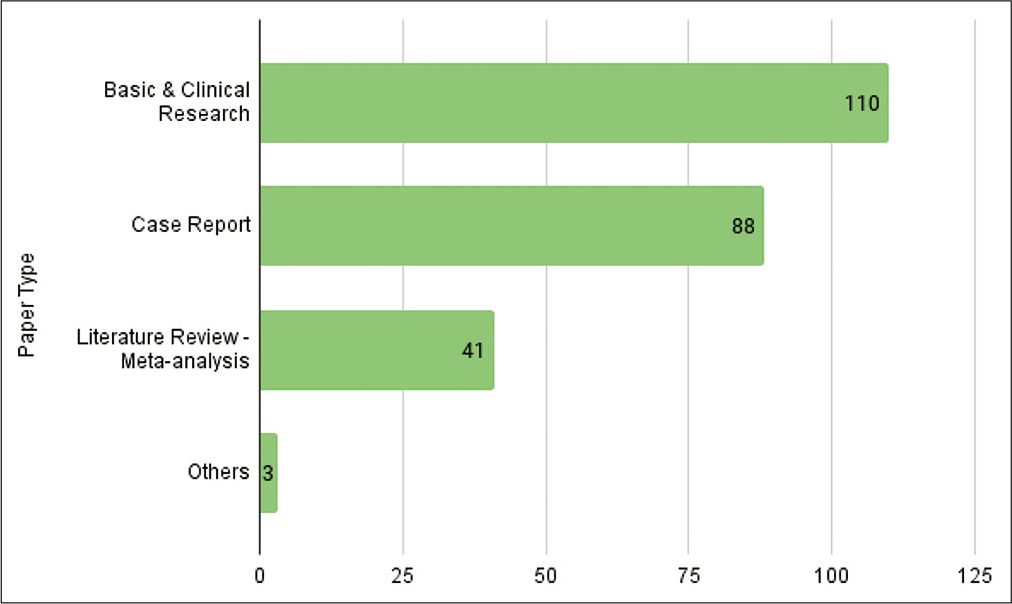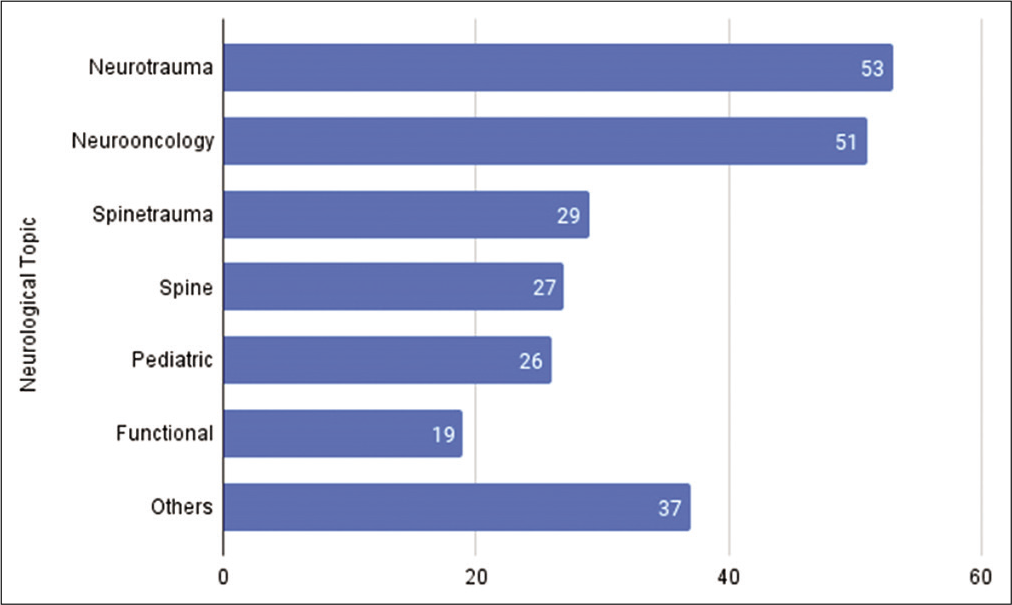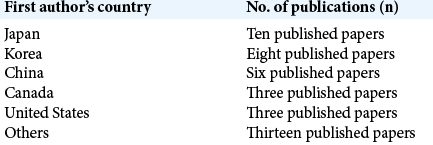- Department of Neurosurgery, Faculty of Medicine, Universitas Padjadjaran - Dr. Hasan Sadikin Hospital, Bandung, West Java,
- Department of Neurosurgery, Faculty of Medicine, Universitas Sam Ratulangi – Prof. Dr. R.D. Kandou Hospital, Manado, North Sulawesi,
- Department of Neurosurgery, Faculty of Medicine, Airlangga University, Surabaya, East Java, Indonesia.
Correspondence Address:
Ahmad Faried, Department of Neurosurgery, Faculty of Medicine, Universitas Padjadjaran - Dr. Hasan Sadikin Hospital, Bandung, West Java, Indonesia.
DOI:10.25259/SNI_908_2021
Copyright: © 2022 Surgical Neurology International This is an open-access article distributed under the terms of the Creative Commons Attribution-Non Commercial-Share Alike 4.0 License, which allows others to remix, transform, and build upon the work non-commercially, as long as the author is credited and the new creations are licensed under the identical terms.How to cite this article: Ahmad Faried1, Eko Prasetyo2, Muhammad Kamil3, Dilli M. A. Pratama1, Sheila Sumargo1. Basic and clinical research publications of Indonesian neurosurgeons: Where are we?. 27-May-2022;13:223
How to cite this URL: Ahmad Faried1, Eko Prasetyo2, Muhammad Kamil3, Dilli M. A. Pratama1, Sheila Sumargo1. Basic and clinical research publications of Indonesian neurosurgeons: Where are we?. 27-May-2022;13:223. Available from: https://surgicalneurologyint.com/surgicalint-articles/11620/
Abstract
Background: With changes in European and the US academia and education systems, research has become a measurement to define academic productivity, as it is a crucial component in the process of becoming a well-trained neurosurgeon. In this recent study, we aimed to reveal the current status and challenges facing neurosurgical research in Indonesia.
Methods: An open-access PubMed MEDLINE database search was performed to reveal all articles published by Indonesian Neurosurgeons from 1980 to July 2021. The detail was extracted to the following parameters: academia center or city of the study, year of publication, study type, topic, journal, institution and Q status, first author, article citation, international collaboration, and the working field. These data were processed and examined.
Results: During 1980 and July 2021, a total of 242 PubMed-indexed papers were published from Indonesia. The number of publications started increasing significantly from 2010 to 2021, with an average of 19 papers per year since 2010. Most of the studies came from Bandung (22.7%), with Universitas Padjadjaran as the center of the study. According to the paper type, the majority of the articles were basic and clinical research (45.5%). The most common study type was case reports (33.5%). Neurotrauma (21.9%) was the most frequent topic followed by neuro-oncology (21.07%) and spine trauma (11.98%).
Conclusion: Published articles in the neurosurgery field in Indonesia has shown a higher, promising trend. Despite many challenges faced in the process, there was significant progress in the past few decades compared to the previous ones. A comprehensive deliberate plan and multidisciplinary effort that focuses on overcoming the problems regarding defining academic productivity is needed for further improvement of neurosurgical care in Indonesia.
Keywords: Indonesia, Neurosurgery, Publications, PubMed
INTRODUCTION
PubMed is a database for the biomedical literature that provides access to MEDLINE, containing bibliographic information on more than 27 million articles from more than 7000 journals which encompass full text for some 4 million of these articles.[
Neurosurgery in Indonesia was started in 1948 by the initiation of a Dutch surgeon who was once the pioneer of neurosurgery in the Netherlands as well.[
The purpose of this study is not only to define or estimate the academic productivity of neurosurgeons in Indonesia but also to emphasize the current challenges facing clinical research, particularly regarding neurosurgery in Indonesia, and to offer potential solutions that can be considered in improving the academic productivity of neurosurgeons in Indonesia.
MATERIALS AND METHODS
An open-access PubMed MEDLINE database search was performed by the authors using various combinations of the following keywords: “Neurosurgery,” “Neurosurgeon,” “Neurological surgery,” “Neurosurgical research,” and “Indonesia.” The final results were including all studies published between 1980 and July 2021. Subsequently, a PubMed exploration by author name was done for all neurosurgeons and neurosurgery residents studying in Indonesia, based on the registry database available from the Indonesian Society of Neurological Surgeons (ISNS).
The inclusion criteria were as follows: (1) published manuscripts of neurosurgery or neuroscience study, (2) study conducted in Indonesia-based neurosurgery services or academic activities, and (3) published manuscripts with, at least, one of the co-authors being an Indonesian neurosurgeon. The exclusion criteria were research conducted by neurosurgeons with nonneurosurgery topics or not in neuroscience fields. Information was extracted to the following parameters: city or center of the study, year of publication, paper and study type, topic, journal, institution and Q status, first author, article citation, international collaboration, and the working field. These data were then processed and examined.
RESULTS
The articles took place in various centers of study. Between 1980 and July 2021, a total of 242 PubMed-indexed papers were published from Indonesia. Most of the studies came from Bandung (n = 55; 22.7%) in which the center of the study was Universitas Padjadjaran, followed by Airlangga University in Surabaya (n = 54; 22.3%), Pelita Harapan University in Tangerang (n = 31; 12.8%), Udayana University in Bali (n = 23; 9.5%), Diponegoro University in Semarang (n = 13; 5.4%), Gadjah Mada University in Yogyakarta (n = 9; 3.7%), University of Indonesia in Jakarta (n = 8; 3.3%), Sumatera Utara University in Medan (n = 8; 3.3%), National Brain Center in Jakarta (n = 6; 2.5%), Hasanuddin University in Makassar (n = 6; 2.5%), and Mataram University in Mataram (n = 3; 1.2%). There were two studies from Balikpapan and Manado. A study was conducted in each of these cities: Aceh, Jambi, Malang, Surakarta, Jember, Purwokerto, Kupang, and Pontianak [
The growth in the number of publications was observed per decade. Only one paper in the period of 1980–1989 was published, with the same amount in the period of 1990–1999. The trend began to rise from 2000 to 2009, in which about 10 papers were published. The number of publications started increasing significantly starting from 2010 to 2019, with a total of 102 papers being published. From 2020 to July 2021, the highest amount of publications occurred with a total of 128 papers [
According to the paper type, the majority of the articles were basic and clinical research (n = 110; 45.5%), followed by literature review – meta-analysis (n = 41; 16.9%), case report (n = 88; 36.4%), and others, such as meeting report or letter to editor (n = 3; 1.2%). Neurotrauma was the most frequent topic (n = 53; 21.90%), followed by neuro-oncology (n = 51; 21.07%), spine trauma (n = 29; 11.98%), spine (n = 27; 11.16%), pediatric (n = 26; 10.74%), functional (n = 19; 7.85%), neurosurgery in COVID-19 era (ranged from education, emergency cases, neurotrauma, neuro-oncology, and vascular) (n = 14; 5.80%), peripheral nerve (n = 9; 3.72%), education (n = 6; 2.48%), infection (n = 4; 1.65%), and others (n = 4; 1.65%) [
DISCUSSION
Our study is the first to define the academic productivity among neurosurgeons in Indonesia during the period 1980–2021. It described not only basic research but also took the condition of clinical research in our nation into discourse. PubMed is a search engine that serves as a database for biomedical literature that plays a significant role in the current academic intellectual landscape. In this study, according to the journal, the majority of the papers were published in Open Access Macedonian Journal of Medical Sciences (n = 28; 11.6%), followed by other four common journals consisting of Asian Journal of Neurosurgery (n = 23; 9.5%), World Neurosurgery (n = 23; 9.5%), Surgical Neurology International (n = 17; 7%), and Annals of Medicine and Surgery (n = 13; 5%).
In this study, the growth in the number of publications was observed. The number of publications started increasing significantly in the past two decades. Factors that were hindering neurosurgical research, particularly before the two decades, could occur due to undeveloped technology, inadequate health system infrastructure, human resource shortages in research, absence of comprehensive patient data recording systems, problems in patient follow-up, deficits in research funding, regulatory and bioethical considerations, lack of international collaborations, and limited access to current evidence. All these factors still have the potentials to hinder the research process since those aforementioned are the main challenges facing clinical research in Indonesia. To address some challenges, health system recovery must be a top priority in the country’s infrastructure-centered agenda.[
Data from the ISNS and Perhimpunan Spesialis Bedah Saraf Indonesia showed that there are only 371 neurosurgeons spread across the country, with a neurosurgeon to population ratio of 1:725,000.[
From the top three, the most neurosurgical articles came from Universitas Padjadjaran (22.7%) with an average impact factor (IF) of 1.68, an average Q index of 2.38, and a total citation of 375. It was followed by other four common institutions consisting of Airlangga University (22.3%) with an average IF of 1.80, an average Q index of 2.33, and a total citation of 315; Pelita Harapan University (12.8%) with an average IF of 1.73, an average Q index of 2.12, and a total citation of 321; Udayana University (9.5%) with an average IF of 1.12, an average Q index of 2.73, and a total citation of 83; and Diponegoro University (5.4%) with an average IF of 1.92, an average Q index of 2, and a total citation of 30. Based on the first author and the amount of publishing, Faried et al. (n = 14; 5.8%) from Universitas Padjadjaran were found to be the most frequent, followed by Arifin et al. (n = 9; 3.7%) from Universitas Padjadjaran, Pranata et al. (n = 8; 3.3%) from Pelita Harapan University, Suryaningtyas et al. from Airlangga University, and Arifin et al. from Diponegoro University (n = 7; 2.9%).
Regarding the published studies, neurotrauma was found to be the most frequent topic, which can be related to the frequency of neurotrauma cases in the country. Neurotrauma, or also commonly known as traumatic brain injury (TBI), is one of the main causes of death not only in low- and middle-income countries (LMICs) but also in high-income countries.[
The article with the most amount of citations was titled “Impact of cerebrovascular and cardiovascular diseases on mortality and severity of COVID-19 systematic review, meta-analysis, and meta-regression” by Pranata et al., which was published in 2020 with a total citation of 166. It was followed by “Consensus statement from the International Consensus Meeting on the Role of Decompressive Craniectomy in the Management of TBI: Consensus statement” (citation of 61) by Hutchinson et al. in 2019; “Multiple spinal extradural arachnoid cysts occurring in a child” (citation of 52) by Suryaningtyas et al. in 2007; “Delayed Ischemic Stroke after Stent-assisted Coil Placement in Cerebral Aneurysm: Characteristics and Optimal Duration of Preventative Dual Antiplatelet Therapy” (citation of 51) by Hwang et al. in 2014; and “Stand-alone Cervical Cages Versus Anterior Cervical Plates in 2-Level Cervical Anterior Interbody Fusion Patients: Analysis of Adjacent Segment Degeneration” (citation of 50) by Ji et al. in 2015. According to international collaborators based on the first author’s country, about 43 of the first authors came from overseas and were involved in the research collaboration with Indonesia. The common five countries consisted of Japan (n = 10; 4.1%), Korea (n = 8), China (n = 6; 2.5%), Canada (n = 3; 1.2%), and the United States (n = 3; 1.2%). The five most common working field with international collaborators were in neuro-oncology (n = 10; 4.1%), spine (n = 10; 4.1%), functional (n = 6; 2.5%), education (n = 4; 1.65%), and pediatric (n = 4; 1.65%) [
Globally, it is estimated that more than 143 million additional surgical procedures are required to prevent mortalities and morbidities. Almost half of these unmet surgical needs can be found in South and Southeast Asia, two regions, where most of the countries are in the LMIC category. If all dimensions of access to surgery (i.e., timeliness, the capacity of workforce and infrastructure, surgical safety, and affordability) are analyzed, slightly more than 90% of the population in Southeast Asia does not have proper access to surgery.[
The primary aim of a neurosurgical educational program is to prepare the neurosurgeon of the future to provide service to a large number of patients where needed, without compromising the quality of care.[
We are aware that this study has several limitations. First, we only use PubMed as a search engine accessing primarily the MEDLINE database of references and abstracts; some keywords for searching may not cover all, and as the consequence some of the publications will be skipped; thus, we only include the English journal indexed. Second, we only collecting the half-year of 2021 since we do not want to miss the momentum to summarize the last data that we could. Finally, we do not acknowledge the increasing number of neurosurgeons growth over the years, which might contribute to the publication’s growth spurt.
CONCLUSION
The number of neurosurgical publications in Indonesia has been showing a higher, promising trend. Despite many challenges faced in the process, there was significant progress in the past few decades compared to the previous decades. A comprehensive deliberate plan and multidisciplinary effort that focuses on overcoming the problems regarding defining academic productivity is needed for further improvement of neurosurgical care in Indonesia.
Authors’ contributions
Ahmad Faried and Eko Prasetyo designed and supervised the entire study. Muhammad Kamil, Dilli Marayuzan Akbar Pratam, and Sheila Sumargo searched the database. Dilli Marayuzan Akbar Pratam and Sheila Sumargo extracted data and reported results. Ahmad Faried and Eko Prasetyo and Muhammad Kamil reviewed the report and provided recommendations on the discussion and conclusion. All authors read and approved the final manuscript.
Declaration of patient consent
Patient’s consent not required as there are no patients in this study.
Financial support and sponsorship
Ahmad Faried is supported by ALG grant from Universitas Padjadjaran, Bandung, West Java, Indonesia.
Conflicts of interest
There are no conflicts of interest.
References
1. Agustina R, Dartanto T, Sitompul R, Susiloretni KA, Suparmi Achadi EL. Universal health coverage in Indonesia: Concept, progress, and challenges. Lancet. 2019. 393: 75-102
2. Alkire BC, Raykar NP, Shrime MG, Weiser TG, Bickler SW, Rose JA. Global access to surgical care: A modelling study. Lancet Glob Health. 2015. 3: e316-23
3. Chen P, Xiong XH, Chen Y, Wang K, Zhang QT, Zhou W. Perioperative management strategy of severe traumatic brain injury during the outbreak of COVID-19. Chin J Traumatol. 2020. 23: 202-6
4. Dewan MC, Rattani A, Fieggen G, Arraez MA, Servadei F, Boop FA. Global neurosurgery: The current capacity and deficit in the provision of essential neurosurgical care. Executive summary of the global neurosurgery initiative at the program in global surgery and social change. J Neurosurg. 2018. 130: 1055-64
5. Ham EI, Kim J, Kanmounye US, Lartigue JW, Gupta S, Esene IN. Cohesion between research literature and health system level efforts to address global neurosurgical inequity: A scoping review. World Neurosurg. 2020. 143: e88-105
6. Handoyo SK. Perspectives in international neurosurgery: Neurosurgery in Indonesia. Neurosurgery. 1980. 6: 105-6
7. Iaccarino C, Carretta A, Nicolosi F, Morselli C. Epidemiology of severe traumatic brain injury. J Neurosurg Sci. 2018. 62: 535-41
8. ISNS Information: List of ISNS Members in Each Province. Available from: http://www.ins.or.id/frontend/detail_news/20 [Last accessed on 2021 Sep 08].
9. Kim DH, Dacey RG, Zipfel GJ, Berger MS, McDermott M, Barbaro NM. Neurosurgical education in a changing healthcare and regulatory environment: A consensus statement from 6 programs. Neurosurgery. 2017. 80: S75-82
10. Leidinger A, Extremera P, Kim EE, Qureshi MM, Young PH, Piquer J. The challenges and opportunities of global neurosurgery in East Africa: The neurosurgery education and development model. Neurosurg Focus. 2018. 45: E8
11. Meara JG, Leather AJ, Hagander L, Alkire BC, Alonso N, Ameh EA. Global Surgery 2030: Evidence and solutions for achieving health, welfare, and economic development. Lancet. 2015. 386: 569-624
12. Ossom Williamson P, Minter CIJ. Exploring PubMed as a reliable resource for scholarly communications services. J Med Libr Assoc. 2019. 107: 16-29
13. Park KB, Johnson WD, Dempsey RJ. Global neurosurgery: The unmet need. World Neurosurg. 2016. 88: 32-5
14. Rosyidi RM, Wardhana DP, Apriawan T, Al Fauzi A, Priyanto B, Gunawan K. Algorithm of traumatic brain injury management at Indonesia in the COVID 19 pandemic ERA. Retrospective cohort study. Ann Med Surg. 2021. 62: 98-103
15. Suryaningtyas W, Wahyuhadi J, Turchan A, Subagio EA, Parenrengi MA, Apriawan T. Neurosurgery at the epicenter of the COVID-19 pandemic in Indonesia: Experience from a Surabaya academic tertiary hospital. Neurosurg Focus. 2020. 49: E5
16. Wicaksono AS, Tamba DA, Sudiharto P, Basuki E, Pramusinto H, Hartanto RA. Neurosurgery residency program in Yogyakarta, Indonesia: Improving neurosurgical care distribution to reduce inequality. Neurosurg Focus. 2020. 48: E5
17. Wittayanakorn N, Nga VD, Sobana M, Bahuri NF, Baticulon RE. Impact of COVID-19 on neurosurgical training in Southeast Asia. World Neurosurg. 2020. 144: e164-77


